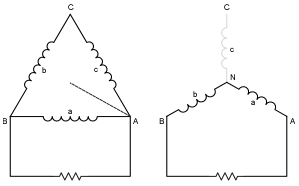In the subject delta connection also, the line current in terminal C is zero.
That is correct... but there is winding current through terminal C. With wye, there is no current through terminal C.
Whereas in delta connection it is phase current that is in dispute for determination 57% single phase capacity, ...
We need to get on the same page regarding terminology. I'm not saying your terminology is wrong, but for this discussion "phase current" is ambiguous when we are talking about winding current. In both delta and wye, the phase current travels through the load. However, with wye windings, phase current travels through two windings and is never in phase with both windings' voltage. With delta, phase currents actually can travel through up to three windings and the winding volatge may influence what current passes through each. Please refer to the following diagram and convention that follows for the remainder of this discussion:
I
A, I
B, and I
C refer to line currents.
I
a, I
b, and I
c refer to winding currents (prefix if necessary: delta- or wye-).
I
AB, I
BC, I
CA, refer to phase currents.
All are vectors (e.g. I
B = -I
A and I
A = 30A < 30? = I
AB)
in star connection it is phase voltage, because the 'neutral' of the single phase load connected between two lines does not coincide with that of the source and so how to ensure that the neutral of the source also not drifted, thereby applicability of factor 1.732 is ensured!
Here is part of the problem I see in your assertions. A winding's kVA rating is given by its nominal voltage times the maximum current irrespective of the voltage and current phase angle relationship (i.e. power factor; if it did the rating would be in kW and it would be done using an assumed power factor). The single phase load on delta has the same voltage at the connected-load terminals for which the windings are rated. The voltage at the terminals on a wye system is 1.732 times the voltage at which the windings are rated. The capacity is "derated" by simple ratio of the nominal voltages.
Also, if we consider neutral drift, then we'd also have to consider "C-terminal" drift for the delta configuration, as there is no load connection to these in either configuration.
In that case actual field testing may provide a clue for the operability of such a generator.
I wish I could. Many real-life circumstances prevent that from happening at this time.
Positive sequence currents do not cause circulating currents in the rotor, whereas negative sequence currents do.
While the rotor's capability is essential to the designed output, what if it is optimized to handle the circulating currents of single phase loading? You then have no argument in this respect.
The same is true for transformer primaries. Essentially true for all electrical equipment... the weak link for the condition of use fails first. For this discussion, we are generalizing. I have only been considering the output windings to be correlated with the output rating... and I believe that's as far as we can go without getting into design specifics.

